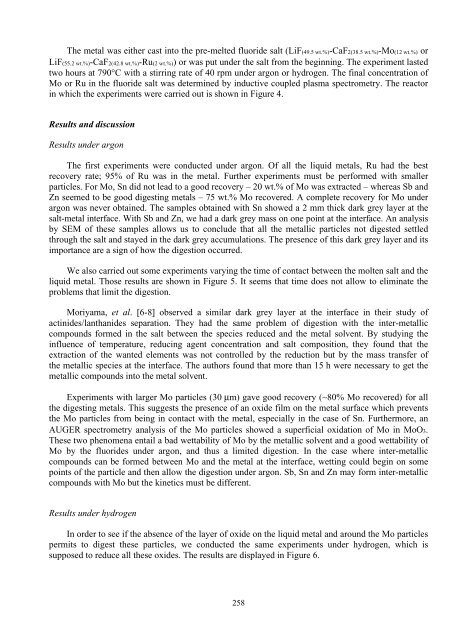Pyrochemical Separations - OECD Nuclear Energy Agency
Pyrochemical Separations - OECD Nuclear Energy Agency
Pyrochemical Separations - OECD Nuclear Energy Agency
You also want an ePaper? Increase the reach of your titles
YUMPU automatically turns print PDFs into web optimized ePapers that Google loves.
The metal was either cast into the pre-melted fluoride salt (LiF(49.5 wt.%)-CaF2(38.5 wt.%)-Mo(12 wt.%) or<br />
LiF(55.2 wt.%)-CaF2(42.8 wt.%)-Ru(2 wt.%)) or was put under the salt from the beginning. The experiment lasted<br />
two hours at 790°C with a stirring rate of 40 rpm under argon or hydrogen. The final concentration of<br />
Mo or Ru in the fluoride salt was determined by inductive coupled plasma spectrometry. The reactor<br />
in which the experiments were carried out is shown in Figure 4.<br />
Results and discussion<br />
Results under argon<br />
The first experiments were conducted under argon. Of all the liquid metals, Ru had the best<br />
recovery rate; 95% of Ru was in the metal. Further experiments must be performed with smaller<br />
particles. For Mo, Sn did not lead to a good recovery – 20 wt.% of Mo was extracted – whereas Sb and<br />
Zn seemed to be good digesting metals – 75 wt.% Mo recovered. A complete recovery for Mo under<br />
argon was never obtained. The samples obtained with Sn showed a 2 mm thick dark grey layer at the<br />
salt-metal interface. With Sb and Zn, we had a dark grey mass on one point at the interface. An analysis<br />
by SEM of these samples allows us to conclude that all the metallic particles not digested settled<br />
through the salt and stayed in the dark grey accumulations. The presence of this dark grey layer and its<br />
importance are a sign of how the digestion occurred.<br />
We also carried out some experiments varying the time of contact between the molten salt and the<br />
liquid metal. Those results are shown in Figure 5. It seems that time does not allow to eliminate the<br />
problems that limit the digestion.<br />
Moriyama, et al. [6-8] observed a similar dark grey layer at the interface in their study of<br />
actinides/lanthanides separation. They had the same problem of digestion with the inter-metallic<br />
compounds formed in the salt between the species reduced and the metal solvent. By studying the<br />
influence of temperature, reducing agent concentration and salt composition, they found that the<br />
extraction of the wanted elements was not controlled by the reduction but by the mass transfer of<br />
the metallic species at the interface. The authors found that more than 15 h were necessary to get the<br />
metallic compounds into the metal solvent.<br />
Experiments with larger Mo particles (30 µm) gave good recovery (∼80% Mo recovered) for all<br />
the digesting metals. This suggests the presence of an oxide film on the metal surface which prevents<br />
the Mo particles from being in contact with the metal, especially in the case of Sn. Furthermore, an<br />
AUGER spectrometry analysis of the Mo particles showed a superficial oxidation of Mo in MoO3.<br />
These two phenomena entail a bad wettability of Mo by the metallic solvent and a good wettability of<br />
Mo by the fluorides under argon, and thus a limited digestion. In the case where inter-metallic<br />
compounds can be formed between Mo and the metal at the interface, wetting could begin on some<br />
points of the particle and then allow the digestion under argon. Sb, Sn and Zn may form inter-metallic<br />
compounds with Mo but the kinetics must be different.<br />
Results under hydrogen<br />
In order to see if the absence of the layer of oxide on the liquid metal and around the Mo particles<br />
permits to digest these particles, we conducted the same experiments under hydrogen, which is<br />
supposed to reduce all these oxides. The results are displayed in Figure 6.<br />
258

















